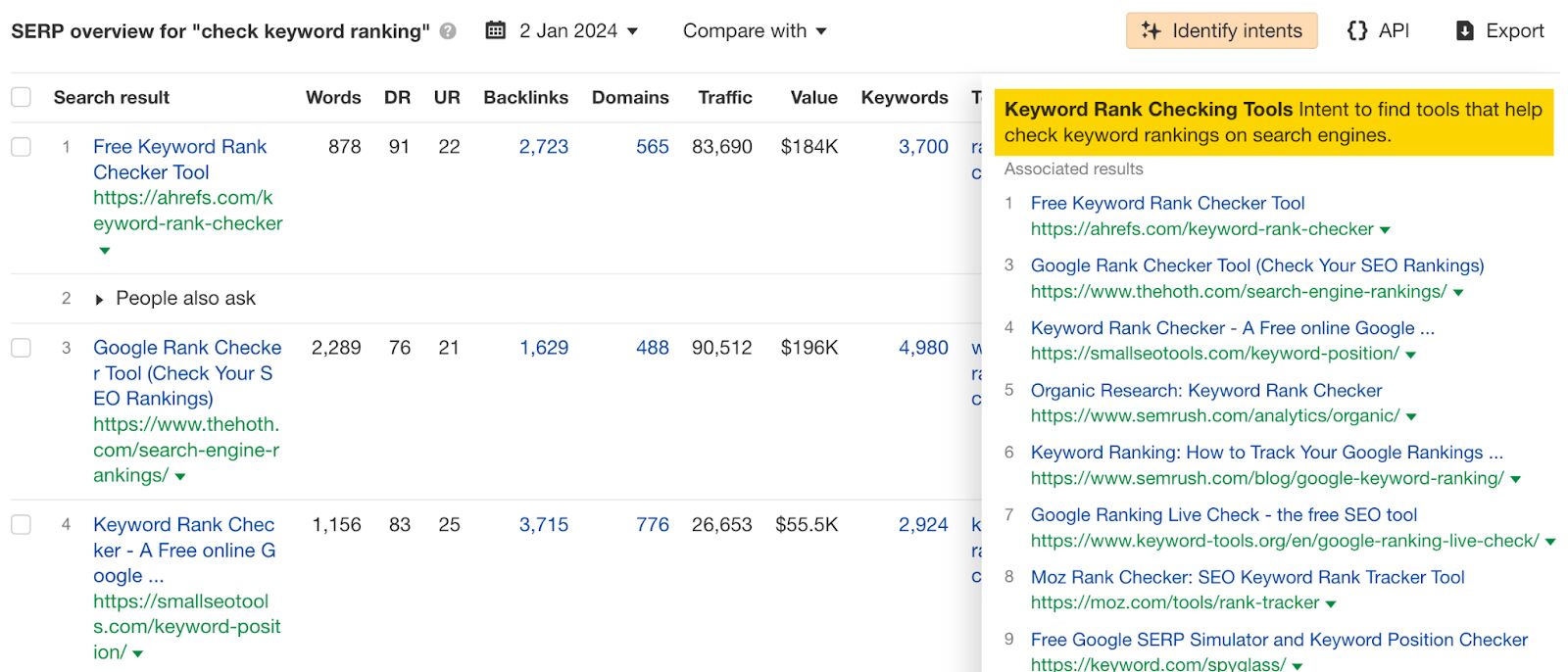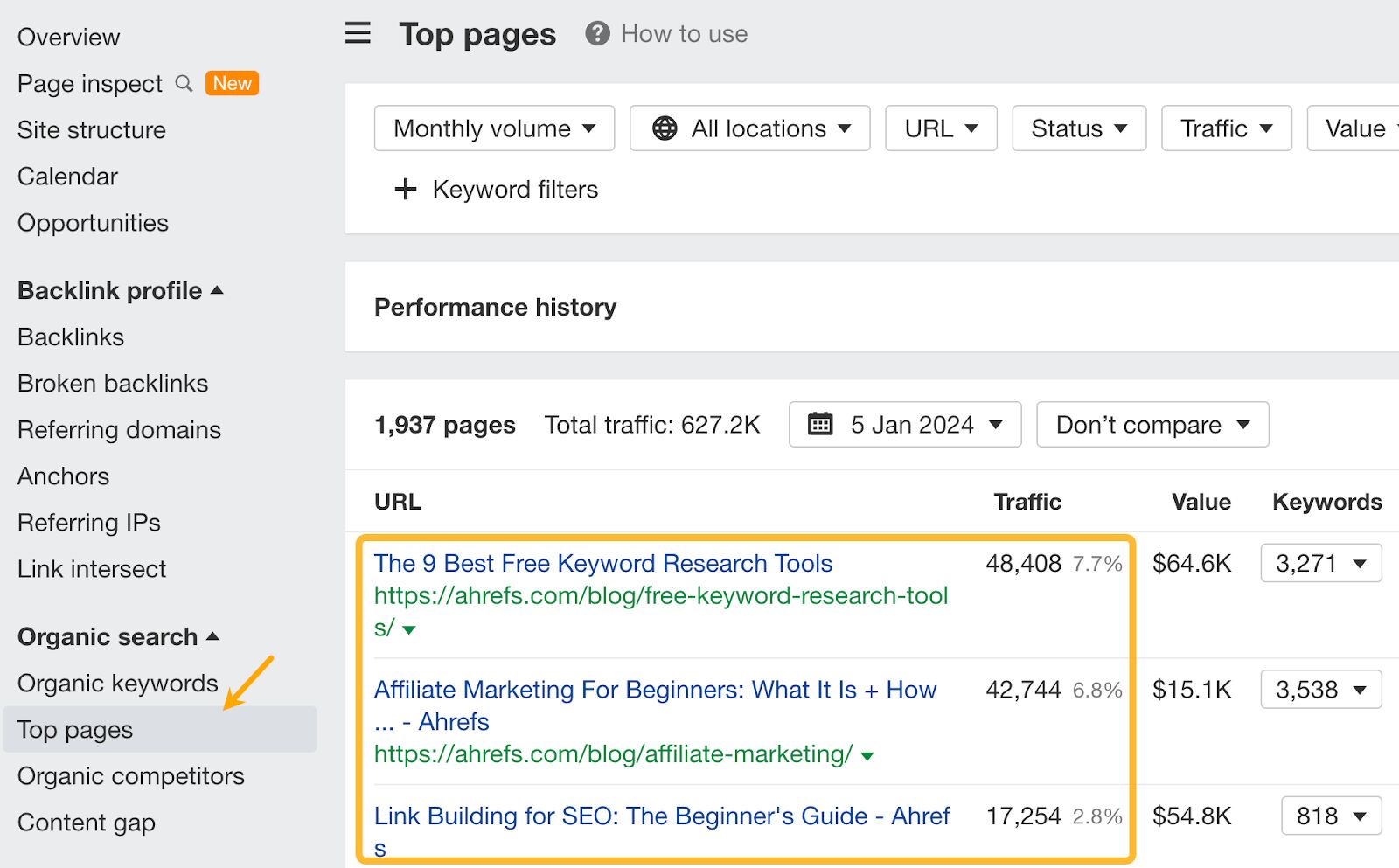To put it simply, this marketing tactic works like this:

From a strategic point of view, the main benefit of investing in SEO for SaaS companies is reducing the customer acquisition cost (CAC). Reason: SEO is cheaper than most marketing tactics, and the traffic you get this way is sustainable and well-targeted.
But, doing SEO for this type of business has challenges and opportunities that you won’t find elsewhere. I’ve tackled a lot of them during my 5+ years of experience in SaaS SEO for all kinds of SaaS – from startups with little organic traffic to $100M+ ARR businesses that are already at the top of their niche.
In this article, I’m sharing a step-by-step guide on how to build an effective SEO strategy for any SaaS company based on that experience.
But first, let’s briefly discuss…
SEO for SaaS companies will be based on the same general principles as any other SEO. You still need keywords with traffic potential, optimized content, and lots of quality links. Moreover, most if not all SEO tactics that work for other companies will work here, too.
The only thing that really makes a difference is the unique ways you can leverage your product to drive targeted traffic with a higher probability of converting. This comes down to three things:
- You should focus on product-led content (content that shows how to solve a problem with your product). This way, each content piece you publish provides immediate value to your audience and creates a natural path to signing up or even subscribing to your content.
- You can integrate your product into the content. For example, a company like Airtable or Asana can share templates to use right inside their products.
- You can literally turn your product into SEO content. Carving out small pieces of the product to make free tools is a great way to get traffic, leads, and backlinks.
Create your strategy following these 10 steps.
Organic competitors are a different thing than direct business competitors.
An organic competitor is any website that ranks for the same keywords as you. This includes not just direct business competitors, but also blogs by industry experts, affiliate websites, and other relevant online platforms
All these types of websites also want a piece of the “organic search” cake. You’ll need a list of these for further SEO research and to track your progress.
The best way to find your organic search competitors is to plug in a dominant website in your niche into Ahrefs’ Site Explorer and head to the Organic competitors report.

Use the report to identify 15-20 competitors in your space — you’ll need them in the next step.
If you find some previously unknown websites in the mix, visit them and decide if they’re similar enough to be included in your list.
To get a more diverse view, you can re-run the report for a couple more relevant websites. If you know that you’re already getting some organic traffic, run the same report with your site as the target.
We’ll make use of the list of your organic search competitors. Consider this an SEO competitor analysis.
The main goal here is to find out what works for your competitors in terms of the:
- Best performing website sections.
- Best performing pages.
- Types of content that attract the most backlinks.
Best performing website sections
Do your competitors drive most of their organic traffic to a blog, product pages, tool pages, a knowledge base, or even some other type of content? What about their approach to website architecture, i.e., how do they structure their URLs?
You’ll find answers to these questions by plugging your competitors’ domains into Ahrefs’ Site Explorer and clicking through the Site structure report:

For example, Hubspot drives the vast majority of its traffic to the blog, but some of their product landing pages crush it in organic search, too.
Best performing pages
Now that we’ve looked at the high-level picture of a website’s organic performance, it’s time to be more granular. In the end, you plan your content piece by piece, so knowing what pieces of content drive the most organic traffic to your competitors is invaluable.
To get this data, simply jump over to the Top pages in Site Explorer.

Go through this report for every competitor and write down content ideas worth covering on your website as well.
However, keep in mind that pages that generate the most traffic don’t necessarily drive a lot of conversions. A lot of them cover top-of-the-funnel topics that have huge search demand. So make sure those content ideas are relevant to your target audience.
Types of content that attract the most links
You’ve probably heard that backlinks are one of the most important ranking factors in SEO. It’s no wonder attracting and building good links to your content is hard.
Some pieces of content can get links much easier than others, though. In SEO, we call this link bait content. This type of content doesn’t necessarily need to drive organic traffic, but it’s valuable, interesting, or unique enough to make other people reference it on their websites.
As with the previous reports in Ahrefs’ Site Explorer, you can also find out which of your competitors’ pages get the most links. Open the Best by links report, select the Best links filter to show the strongest links, and make notes about the type of content that could be considered link bait in your niche.

In the example above, we can spot an industry report from Sprout Social that got over 1k strong links from over 711 referring domains - definitely something to consider replicating.
We’ll talk about creating link bait like that in a bit.
Getting inspired by competitors is essential in SEO, but so is coming up with your own ideas. Keyword research is the most important part of this.
Keyword research is the process of discovering valuable search queries that your target customers type into search engines like Google to look for products, services, and information.
If you’re new to this, make sure to go through our beginner’s guide to keyword research. I’ll just focus on the SaaS SEO aspect here.
In general, keywords in SaaS can be divided into four main categories, each representing a type of content that constitutes a search intent you can see in the SERPs (Search Engine Result Pages):
- Blog posts – “saas seo guide” or “how to build links”.
- Knowledge base pages – “ahrefs domain rating” or “4xx error meaning”
- Product and service landing pages – “backlink checker” or “free seo tool”.
- Comparison and review pages – “best seo tools” or “ahrefs vs moz”.
Anytime you do keyword research or stumble upon a list of keywords relevant to your business, save the keywords to a list that you’ll come back to later when planning content.
We’ll be working with the aforementioned content categories, so labeling the keywords like this right away can save time.
Here’s how it looks like in Ahrefs’ Keywords Explorer (you can do the same in Site Explorer reports too):

There will be many overlapping keywords with mixed search intent. For instance, “saas seo” is relevant to both guides like this and agencies/freelancers offering SaaS SEO services. Stick with the label (search intent) more relevant to your business.
If you’re unfamiliar with search intent, it’s the “why” behind a search query.
The reason we’re advising categorizing keywords by search intent is that search engines always try to provide the most relevant results according to the search intent. So if your content doesn’t match the search intent, it has a lower chances of ranking.
To automate search intent identification, you can use an AI feature called Identify intents in Keywords Explorer.

When selecting keywords, it’s important to look beyond search volume. Consider the Traffic Potential metric — this measures how much organic traffic the top-ranking page for a keyword gets, which can differ significantly from keyword’s search volume.
For example, the keyword ‘content marketing strategy’ in Ahrefs’ Keywords Explorer shows a traffic potential of 11K monthly visits, exceeding its 1.8K U.S. search volume.

Also, assess the Keyword Difficulty score, which predicts the ease of ranking for a keyword on a scale of 0 to 100. The lower the score, the easier it is to rank at the top for the keyword.
Finally, evaluate your ability to create content that surpasses what’s already ranking. Can you offer unique insights or more value? It’s always easier to rank well with content that’s objectively better than what you can find on the SERPs.
Now it’s time we start turning all the research and competitive analysis into content creation.
This whole guide is a great example of product-led content. In this case, it isn’t possible for me to write this guide without mentioning Ahrefs tools.
In fact, product-led content marketing is Ahrefs’ main marketing tactic. Our blog drives almost 600K organic visits every month to articles like the one you’re reading now. In our articles, readers learn about a certain SEO or broader marketing topic while discovering how our SaaS products can help them.

In fact, many successful SaaS companies demonstrate this approach to content. Here’s another example from Asana. Their guide to agile methodology has many references to the functionality of the product yet none of them feels forced because they are relevant to the topic.

This one article gives them an estimated 27.9K monthly visits.

Of course, the degree to which you can pitch your product within an article varies. It’s always better not to mention your product if it feels unnatural or too pushy.
To solve this, you can use a metric we call “business potential.” For every keyword we’re thinking about covering on our blog, we give it a business potential score. This score is an estimation, showing to what degree a keyword can let us naturally pitch our product.

Many companies have found making products (or just a fraction of them) accessible without any friction to be a successful marketing tactic. These landing pages can drive traffic, attract backlinks, make people familiar with your product, generate leads, and even convert some visitors.
At Ahrefs, we have seen significant success in offering free tools. These also play an important part in our SEO strategy and overall growth. So far, we’ve released 14 free SEO tools plus a handful of free AI writing tools that anyone can try right away:

All these landing pages of free tools combined generate over 1.2M organic traffic per month:

Naturally, to get this kind of traffic, there must be a search demand for the tool in the first place. Use the traffic potential metric to gauge that demand, but don’t forget to check the search intent, as well.

Huge traffic potential isn’t the only benefit of having a spin-off of our product as a landing page. Our tools can also act as link bait, which we explained earlier.
Many of these pages have a high URL Rating (UR) that is a proxy metric to a page’s link profile strength:

The same principles of prioritizing content creation apply here as well. Some tools will be more valuable than others because they may attract a more relevant audience. Some SERPs will already be full of tools that do more or less the same thing, so it will be difficult to get to the top if you don’t innovate.
On top of the regular SEO prioritization criteria, you’ll also need to think about developer resources. They’re scarce for us SEOs, so you’d better allocate them to a page that can pay off nicely in the future.
We’ve covered the main use cases for keyword research. But there’s still a type of content that doesn’t necessarily need to be driven by traffic potential: industry insights and studies.
The beauty of SaaS businesses is that they often have tons of data that can be analyzed and interpreted into industry insights. For example, one of my latest data studies is about the way Google handles title tags after one of its controversial updates:
https://twitter.com/michalpecanek/status/1460692564797972485
The study isn’t supposed to drive any organic traffic. But it is a great opportunity to get more links that can help our regular title tags article (and others) rank better on the SERPs, thanks to the backlinks it got (and will get).
We’ve published quite a few of these studies and insights. They’re without a doubt the best type of link bait content on our blog:

It’s no surprise. Claims with data or interesting findings are pieces of information that find their way into many articles.
As with the free tools, this is a type of content that a writer can’t usually produce alone. You’ll probably need help from your data science team. Just make sure that the hypotheses and potential findings truly stand out; this will help you achieve your desired SEO outcomes.
One more thing. Content distribution plays an even more important role here (as compared to content distribution for your standard articles). In the end, if there’s no search volume, then you need to actively push the content in front of people’s eyes to get clicks. Here are a few tips for that:
- Plan an outreach campaign to get backlinks and/or exposure from prominent people in your niche.
- Promote the content using social media ads on top of the standard organic social posts that usually have limited reach.
- Share it with your email subscribers.
- Repurpose your content into social media posts, answers on Quora, newsletters, etc., and then share repeatedly.
- Update your internal links so readers of your other articles can click through and pages can pass their link equities.


Typically, when creating SEO content, you tackle a single keyword with a unique, manually created page. In the programmatic approach, you tackle a broad topic with 10s or even 100s of similar pages created in an automatic or a semi-automatic way at once.
Zapier is a legendary example of programmatic SEO. They used it to tap into branded search demand of over 6.7k apps they integrate with.

Each app page is almost identical. What changes are a few short text fields and the list of tasks you can automate with a given app.
This entire content hub brings an estimated 263k visits each month.

In some cases, you can leverage user-generated content instead of creating everything yourself. An example of this is Notion with their directory of thousands of templates, largely created by users.

As a result, that directory of templates drives an estimated 355K organic visits each month.

The key to programmatic SEO is finding keywords that scale:
- Similar keywords with a lot of variations, e.g., “seo for realtors”, “seo for caterers”, etc.
- Keywords having a similar underlying theme that can be served under one content directory. For example, you could create a glossary of basic terms in your niche or a hub where you share similar data points on something relevant to your audience (e.g. this directory of SEO data on top pages on the web).
The easiest way to do this is to look for patterns among keywords using keyword modifiers. For instance, let’s say that cost of living is something relevant to your business and your audience. Using “in” as the modifier would allow you to spot this pattern:

Speaking in your audience’s language is a must if you’re targeting a global market.
Simply put, some people prefer to enter search queries in their native language and expect search results in that same language. As obvious as this reason may sound, it can be easily overlooked because marketers tend to think it’s enough to write everything in English.
There are three pieces of the international SEO puzzle:
- Technical — you need to pick a URL structure, use hreflang tags properly, and consider investing in a CDN service (i.e., a server closer to the target country for loading speed reasons).
- Translated content — best if written by a native or at least edited by one.
- Local backlinks — to compete in localized SERPs, you’ll need quality links from countries (and languages) where you want to rank.
But localizing literally every page on your site may not be the most efficient way to go about it. Search volumes can differ between countries so to make sure you’re spending your resources right. Aim to translate your top-performing content but only if the search volume in the target country is worth your time.
Here’s how to get started.
First, use a tool like Ahrefs’ Site Explorer to get a list of your top-performing pages. In Ahrefs, you’d use the Top pages report:

Next, you can then use a tool like ChatGPT to show you possible translations of target keywords, which can then help you simulate a search in that language on Google, using the free Ahrefs SEO Toolbar. This approach allows you to gauge the traffic potential of a topic in different languages and regions.
For instance, a leading French article on “free keyword research tools” receives about 714 organic visits monthly from France, suggesting potential value in content translation.

Branded keywords contain your company, service, or product name. Optimizing for them is about creating dedicated pages or improving existing ones to serve the search intent behind these keywords.

If your brand is new, you likely won’t have many of those. But as your brand grows in popularity, people will start to Google things related to your brand more and more.
Here’s the thing — in most cases, traffic from branded search will flow straight to you, but if you don’t monitor these keywords, you may miss out on some opportunities. Our Keywords Explorer has a nifty filter called Target to help you find these:
- Enter your brand name and/or products’ name. You can also use some common misspellings.
- Go to the Matching terms report.
- Open the Target filter, enter your domain, set it to “Show ranking positions” and hit Apply.

This way you will see all branded keywords and where you rank for them (if you rank at all).

Here’s what to look for:
- Keywords where you don’t rank or rank low. If they’re actually relevant, it could be something worth optimizing for. For example, we don’t rank at all for “how to pronounce ahrefs” and we should.
- Comparison keywords like “ahrefs vs majestic”. These can be incredibly valuable because people looking up these keywords are close to making a purchase.
- Questions and requests like “ahrefs affiliate program”, “ahrefs domain rating”.
- Feature requests in disguise like “ahrefs data studio” (we didn’t always have this feature).
For example, we decided to give a shot at some of the most popular comparison keywords with a landing page showing unique features.

This way, we can get an estimate of 2K organic visits per month from people interested in how we stack up against the competition.

Apart from capturing the traffic from the branded keywords, you may see an interesting phenomenon — fulfilling the search demand can grow that demand.
Last but not least, we have to talk about technical SEO briefly.
Everything that we went through so far is related to on-page and off-page SEO for SaaS businesses. But if your technical foundation isn’t right, it may be all for nothing—no matter how good your content is or the links you get.
You need to make sure that search engines can easily access and properly process the content that you want to rank with on the SERPs. Yes, this can involve many things, but it isn’t rocket science.
The best thing you can do is to set up regular crawls in Ahrefs’ Site Audit (free in Ahrefs Webmaster Tools). Our crawler will go through your website and create a comprehensive report that will tell you what’s possibly wrong and how to fix it:

A good proxy to your overall state of technical SEO is then the Health Score:

You’re also in luck here. SaaS websites aren’t usually complex from a technical SEO perspective because they’re generally rather small. Anyone who does e-commerce SEO and works on websites consisting of millions of pages will likely laugh at our technical SEO problems.
Final thoughts
Providing the best SaaS SEO tips I can think of is one thing. But making sure that all of this makes sense in the big picture of marketing is another. Make sure that everything you do in SEO aligns with your overall marketing strategy and objectives.
On top of that, SEO is a multidisciplinary field, so broadening your skills in other marketing areas always comes in handy. For example, I recently led the way in creating a newsletter for a client to improve their content distribution to get the views and links before it starts ranking organically.
Got any questions or insights that you want to share? Ping me on X.



